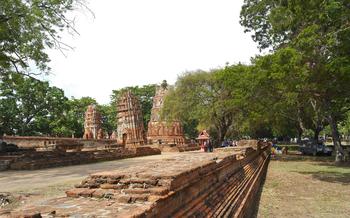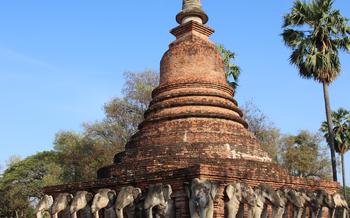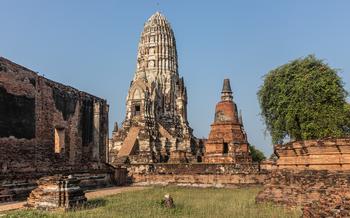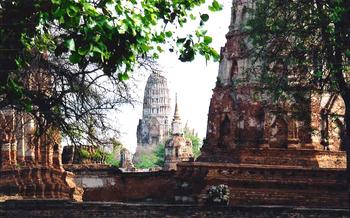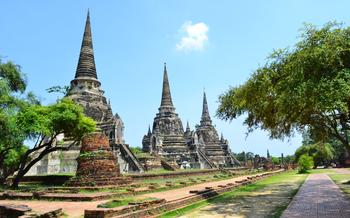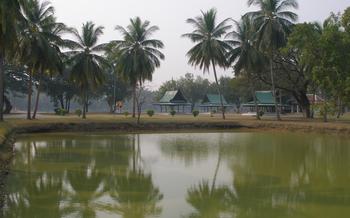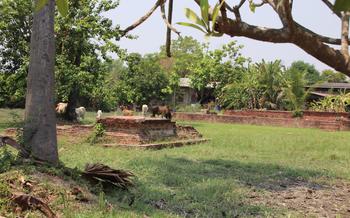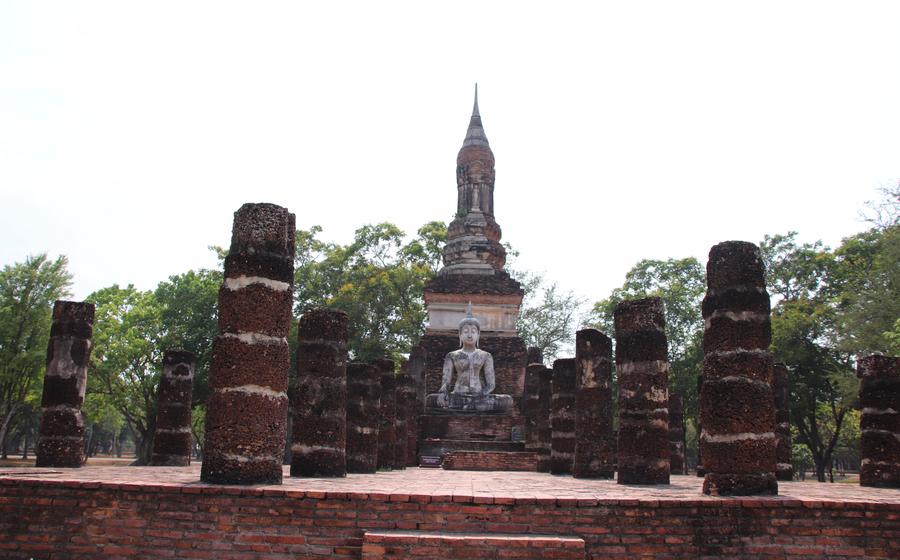
Wat Mahathat (Ayutthaya)
- Wat Mahathat: A Historical Gem
- Exploring the Ruins
- The Central Prang: A Symbol of Power and Majesty
- The Buddha Images
- The Inner Sanctuary
- The Outer Gallery
- The Stupas
- The Ordination Hall: A Place of Sacred Rituals
- The Surrounding Area
- Photography Tips:
- Dress Code and Etiquette
- Guided Tours
- Insider Tip: Unveiling the Secrets of Wat Mahathat
Wat Mahathat: A Historical Gem
Wat Mahathat, nestled in the heart of the ancient city of Ayutthaya, stands as a testament to Thailand's rich history and cultural heritage. Constructed in the 14th century during the Ayutthaya Kingdom, this grand temple complex played a pivotal role as a religious and royal center. Its enduring legacy, coupled with its exquisite architecture and captivating ruins, attracts visitors worldwide, making it a must-visit destination for anyone seeking a deeper understanding of Thailand's past.
The temple's name, Wat Mahathat, translates to "Temple of the Great Relic," highlighting its significance as a repository for sacred relics of the Buddha. Throughout centuries of existence, Wat Mahathat has undergone several renovations and expansions, reflecting the evolving artistic styles and religious beliefs of the Ayutthaya era. Despite the ravages of time and wars, the temple's majestic ruins continue to captivate visitors with their grandeur and intricate details, offering a glimpse into the splendor of this once-mighty kingdom.
Exploring the Ruins
The ruins of Wat Mahathat are a testament to the grandeur and artistry of the Ayutthaya Kingdom. As you wander through the grounds, you'll encounter various ancient structures, each with its own unique story to tell.
The most striking feature is the central prang, a towering spire that dominates the skyline. Surrounding it are numerous Buddha images, some seated in meditation, others standing in majestic poses. The intricate carvings that adorn these statues are a testament to the skill and devotion of the ancient artisans.
As you explore further, you'll come across remnants of stupas, once used for storing relics and sacred objects. These structures vary in size and style, reflecting the different periods in which they were built. Restoration efforts are ongoing to preserve these ruins and bring them back to their former glory.
The Central Prang: A Symbol of Power and Majesty
The central prang, also known as the main prang, dominates the skyline of Wat Mahathat. Standing tall and majestic, it represents Mount Meru, the sacred mountain at the center of the Buddhist universe. It symbolizes the connection between the earthly and celestial realms and is the focal point of the temple complex.
The prang is a towering structure, reaching a height of over 50 meters. It features a distinctive design, consisting of a square base that gradually tapers to a point at the top. The sides of the prang are adorned with intricate carvings and sculptures depicting mythological figures and scenes from Buddhist mythology.
The architectural design of the central prang reflects the Khmer influence in Sukhothai architecture. It resembles the prangs found in the temple complexes of Angkor in Cambodia, such as Angkor Wat and Angkor Thom. The similarities in design suggest the close cultural and historical ties between the two kingdoms.
Surrounding the central prang are four smaller prangs, each representing a different direction - north, south, east, and west. These prangs are slightly smaller in size and height but share the same architectural features and design elements. Together, the five prangs create a harmonious and symmetrical composition that adds to the grandeur of the temple complex.
The Buddha Images
The Wat Mahathat complex is home to a diverse collection of Buddha images, each possessing unique characteristics and artistic styles. These images, ranging from towering figures to intimate statuettes, offer a glimpse into the rich history and spiritual traditions of Thailand.
The Buddha images at Wat Mahathat are predominantly crafted from bronze or stone and exhibit various postures and mudras, each symbolizing different aspects of the Buddha's teachings. Visitors can admire the serene countenance of the seated Buddha statues, radiating an aura of tranquility and inner peace. In contrast, the standing Buddha images exude a sense of strength and determination, embodying the Buddha's unwavering resolve on the path to enlightenment.
The intricate details and craftsmanship of these Buddha images are truly remarkable. The sculptors have meticulously carved each feature, from the delicate lines of the Buddha's face to the graceful folds of his robes, creating a sense of realism and devotion. The images are adorned with intricate jewelry and elaborate headdresses, reflecting the reverence and respect accorded to the Buddha in Thai culture.
Preserving these Buddha images is of utmost importance, as they represent a tangible link to Thailand's rich Buddhist heritage. Restoration efforts have been undertaken to conserve and protect these sacred relics, ensuring that future generations can continue to appreciate their beauty and significance.
The Inner Sanctuary
The inner sanctuary of Wat Mahathat is a sacred space that houses the temple's most revered Buddha statue. This majestic statue, known as the "Phra Buddha Sihing," is a colossal bronze image that exudes an aura of serenity and devotion. It sits serenely within a grand pavilion, surrounded by intricate carvings and elaborate decorations that pay homage to its significance.
The inner sanctuary is the heart of Wat Mahathat, where devotees come to pay their respects and seek spiritual guidance. It is a place of deep reverence and tranquility, where the air is thick with the scent of incense and the gentle chanting of prayers. Visitors are welcome to enter the inner sanctuary, but they are expected to maintain a respectful demeanor and observe local customs and traditions.
Rituals and ceremonies are often performed in the inner sanctuary, adding to its spiritual significance. Monks gather here to chant sacred texts, offer prayers, and conduct blessings. During special occasions and festivals, the inner sanctuary transforms into a vibrant space, adorned with colorful decorations and offerings made by devotees.
The spiritual significance of the inner sanctuary lies in its representation of the Buddha's teachings and the path to enlightenment. The Buddha statue serves as a reminder of his presence and compassion, inspiring visitors to reflect on their own spiritual journey and strive for inner peace and harmony.
The Outer Gallery
The outer gallery of Wat Mahathat is an architectural marvel that encloses the inner sanctuary. It features a series of colonnades and walkways that provide a shaded and serene space for visitors to explore. The gallery is lined with numerous Buddha images, each with its unique size, style, and artistic representation. These images reflect the diverse artistic traditions that have influenced the development of Thai Buddhist art over the centuries.
In addition to the Buddha images, the outer gallery also houses several historical inscriptions. These inscriptions provide valuable insights into the history of the temple, its royal patrons, and the events that have shaped its existence. They offer a glimpse into the rich cultural and religious heritage of Sukhothai and serve as a reminder of the significance of this ancient city.
The architectural details of the outer gallery are equally impressive. The columns that support the roof are adorned with intricate carvings and sculptures, showcasing the craftsmanship and artistry of the ancient builders. The gallery's design allows for natural ventilation, creating a cool and refreshing atmosphere even during the hot Thai summers.
Strolling through the outer gallery, visitors can appreciate the harmonious blend of artistic expression and historical significance. It offers a unique perspective on the religious and cultural heritage of Sukhothai and provides a glimpse into the lives of the people who once worshipped and lived within the temple complex.
The Stupas
The stupas at Wat Mahathat are another significant feature of the temple complex. These bell-shaped structures hold immense symbolism and significance in Buddhist culture. They represent the enlightened mind of the Buddha and serve as a reminder of his teachings.
There are several stupas of varying styles and variations scattered throughout the temple grounds. Some are tall and slender, while others are shorter and more squat. Some are adorned with intricate carvings and designs, while others are more simplistic in their appearance.
Historically, stupas were used as burial mounds for the Buddha's relics or those of his prominent disciples. Over time, they evolved into symbolic representations of the Buddha's teachings and became an integral part of Buddhist architecture.
Many of the stupas at Wat Mahathat have undergone extensive restoration efforts in recent years. This has helped to preserve these ancient structures and ensure their continued existence for future generations.
The Ordination Hall: A Place of Sacred Rituals
The Ordination Hall, also known as the Ubosot, holds a significant place within the temple complex. Historically, it served as a sacred space for monks to undergo the ordination ceremony, where they formally entered the Buddhist monastic order. The hall's architectural features reflect its religious purpose, with its rectangular shape, gabled roof, and ornate decorations. Inside, the hall houses a large Buddha image, symbolizing the presence of the Buddha as the witness and protector of the ordination ceremony.
In addition to its historical significance, the Ordination Hall continues to play an important role in the temple's rituals and ceremonies. It is used for various Buddhist ceremonies, including ordinations, merit-making ceremonies, and meditation sessions. The hall's serene atmosphere and sacred ambiance make it a suitable place for such spiritual practices.
Although the Ordination Hall is primarily a religious space, it has also gained cultural and historical significance. It represents the continuity of Buddhist traditions and practices in Thailand, serving as a testament to the deep-rooted Buddhist faith among the Thai people. The hall's well-preserved condition and intricate artwork make it an attraction for both religious pilgrims and those interested in Thai culture and history.
The Surrounding Area
Beyond the temple grounds, the Wat Mahathat Historical Park offers visitors a glimpse into the ancient city of Sukhothai. The ancient city walls, which once protected the city from invaders, are still standing in some sections, providing a sense of the city's former grandeur. Within the park, visitors can also explore historical sites such as the Sukhothai Historical Museum and the Ramkhamhaeng National Museum, which provide insights into the history and culture of the Sukhothai Kingdom.
For those seeking a more immersive experience, local markets offer a vibrant atmosphere and a chance to sample delicious Thai cuisine. Visitors can find everything from fresh produce to handmade crafts, as well as local specialties like Sukhothai noodles and Sukhothai sticky rice.
Accommodation options are available within the park and in the surrounding area, catering to various budgets and preferences. From guesthouses to luxury resorts, visitors can choose the perfect place to stay and make the most of their time in this historical and cultural destination.
Photography Tips:
To capture the essence and beauty of Wat Mahathat, follow these photography tips:
-
Best Angles and Lighting Conditions: Arrive early in the morning or late in the afternoon to take advantage of the soft, golden light that enhances the intricate details of the temple. Experiment with different angles to find unique perspectives that showcase the grandeur and symmetry of the architecture.
-
Capturing the Details: Use a macro lens or get close to capture the intricate carvings, Buddha images, and decorative elements that adorn the temple. Focus on the details to reveal the craftsmanship and artistry that went into creating these masterpieces.
-
Composition and Perspective: Play with different compositions to create visually appealing images. Use leading lines, such as the colonnades or walkways, to draw the viewer's eye into the frame. Experiment with different perspectives, including high vantage points or low angles, to add depth and interest to your shots.
-
Ethical Considerations: Remember to be respectful when taking photos of people, especially monks or worshippers. Always ask for permission before photographing individuals, and be mindful of their privacy.
Dress Code and Etiquette
When visiting Wat Mahathat, it is important to dress respectfully and follow local customs and traditions. Appropriate attire includes long pants or skirts that cover the knees, and shirts that cover the shoulders. Avoid wearing revealing or transparent clothing. It is also considered disrespectful to wear shoes inside religious buildings, so remember to remove your footwear before entering the temple.
Respectful behavior is essential when visiting any religious site. Avoid speaking loudly, talking on your phone, or engaging in disruptive activities. Be mindful of your body language and gestures, and try to avoid pointing your feet at Buddha images or other sacred objects. It is also important to be respectful of the local culture and traditions. For example, it is customary to wai (a traditional Thai greeting) when entering and leaving the temple, and to avoid touching or climbing on Buddha images.
By following these guidelines, you can show your respect for the local culture and traditions, and ensure that you have a positive and meaningful experience at Wat Mahathat.
Guided Tours
Deciding whether to explore Wat Mahathat with a guide or independently is a personal preference. Guided tours offer several advantages, including insights into the history, culture, and significance of the site. Knowledgeable guides can provide valuable information about the ancient structures, Buddha images, and religious practices associated with the temple complex. They can also help you navigate the vast grounds and ensure you don't miss any hidden gems.
However, guided tours can also be limiting, as they typically follow a set itinerary and may not allow for as much flexibility or exploration at your own pace. If you prefer a more independent experience, you can explore the ruins on your own, using guidebooks, maps, or online resources to learn about the site's history and significance.
If you do decide to opt for a guided tour, choosing a reputable and experienced guide is essential. Look for guides licensed by the Tourism Authority of Thailand (TAT) and read reviews from previous travelers to gauge their knowledge and professionalism. Consider your interests and preferences when selecting a tour, as some guides may specialize in specific aspects of the temple complex, such as its history, architecture, or religious significance.
To make the most of your guided tour, come prepared with questions and engage actively with your guide. Don't hesitate to ask for clarification or additional information if something is unclear. Remember to tip your guide appropriately at the end of the tour as a gesture of appreciation for their services.
Insider Tip: Unveiling the Secrets of Wat Mahathat
Beyond the main attractions, Wat Mahathat holds a trove of hidden gems waiting to be discovered. Venture off the beaten path to uncover secluded corners adorned with exquisite carvings, serene Buddha images nestled among the ruins, and ancient stupas shrouded in mystery.
One such hidden gem is the Phra Mongkhon Bophit Buddha image, located within the inner sanctuary. This colossal bronze Buddha statue exudes an aura of tranquility and reverence, inviting visitors to pause and reflect on the temple's rich spiritual heritage.
For a unique photo opportunity, climb the narrow staircase leading to the top of the central prang. From this vantage point, you'll be rewarded with breathtaking panoramic views of the temple complex and the surrounding countryside.
To avoid the crowds and experience the temple's serene ambiance, plan your visit during the early morning or late afternoon. This is also the best time to capture the temple's architectural grandeur in soft, golden light.
Finally, time your visit to coincide with one of the temple's many festivals or events. During these special occasions, Wat Mahathat transforms into a vibrant hub of activity, with colorful processions, traditional performances, and a festive atmosphere that brings the temple's history to life.
